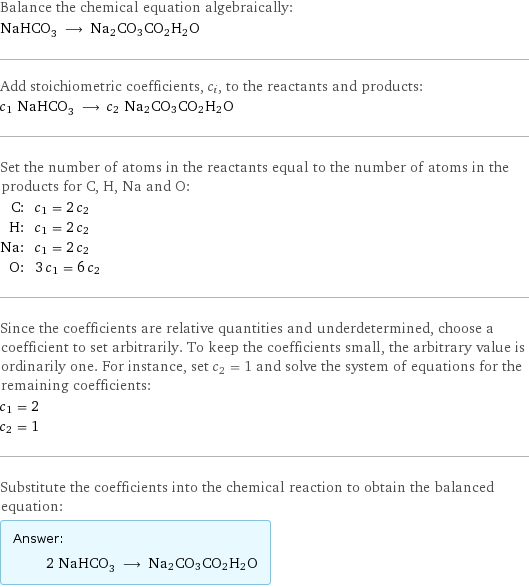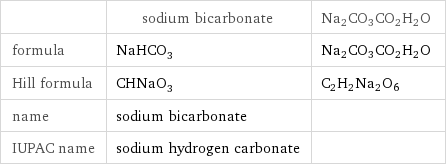Input interpretation

NaHCO_3 sodium bicarbonate ⟶ Na2CO3CO2H2O
Balanced equation

Balance the chemical equation algebraically: NaHCO_3 ⟶ Na2CO3CO2H2O Add stoichiometric coefficients, c_i, to the reactants and products: c_1 NaHCO_3 ⟶ c_2 Na2CO3CO2H2O Set the number of atoms in the reactants equal to the number of atoms in the products for C, H, Na and O: C: | c_1 = 2 c_2 H: | c_1 = 2 c_2 Na: | c_1 = 2 c_2 O: | 3 c_1 = 6 c_2 Since the coefficients are relative quantities and underdetermined, choose a coefficient to set arbitrarily. To keep the coefficients small, the arbitrary value is ordinarily one. For instance, set c_2 = 1 and solve the system of equations for the remaining coefficients: c_1 = 2 c_2 = 1 Substitute the coefficients into the chemical reaction to obtain the balanced equation: Answer: | | 2 NaHCO_3 ⟶ Na2CO3CO2H2O
Structures

⟶ Na2CO3CO2H2O
Names

sodium bicarbonate ⟶ Na2CO3CO2H2O
Equilibrium constant
![Construct the equilibrium constant, K, expression for: NaHCO_3 ⟶ Na2CO3CO2H2O Plan: • Balance the chemical equation. • Determine the stoichiometric numbers. • Assemble the activity expression for each chemical species. • Use the activity expressions to build the equilibrium constant expression. Write the balanced chemical equation: 2 NaHCO_3 ⟶ Na2CO3CO2H2O Assign stoichiometric numbers, ν_i, using the stoichiometric coefficients, c_i, from the balanced chemical equation in the following manner: ν_i = -c_i for reactants and ν_i = c_i for products: chemical species | c_i | ν_i NaHCO_3 | 2 | -2 Na2CO3CO2H2O | 1 | 1 Assemble the activity expressions accounting for the state of matter and ν_i: chemical species | c_i | ν_i | activity expression NaHCO_3 | 2 | -2 | ([NaHCO3])^(-2) Na2CO3CO2H2O | 1 | 1 | [Na2CO3CO2H2O] The equilibrium constant symbol in the concentration basis is: K_c Mulitply the activity expressions to arrive at the K_c expression: Answer: | | K_c = ([NaHCO3])^(-2) [Na2CO3CO2H2O] = ([Na2CO3CO2H2O])/([NaHCO3])^2](../image_source/a38a7494cad9ad6eb7a2811c51720cc1.png)
Construct the equilibrium constant, K, expression for: NaHCO_3 ⟶ Na2CO3CO2H2O Plan: • Balance the chemical equation. • Determine the stoichiometric numbers. • Assemble the activity expression for each chemical species. • Use the activity expressions to build the equilibrium constant expression. Write the balanced chemical equation: 2 NaHCO_3 ⟶ Na2CO3CO2H2O Assign stoichiometric numbers, ν_i, using the stoichiometric coefficients, c_i, from the balanced chemical equation in the following manner: ν_i = -c_i for reactants and ν_i = c_i for products: chemical species | c_i | ν_i NaHCO_3 | 2 | -2 Na2CO3CO2H2O | 1 | 1 Assemble the activity expressions accounting for the state of matter and ν_i: chemical species | c_i | ν_i | activity expression NaHCO_3 | 2 | -2 | ([NaHCO3])^(-2) Na2CO3CO2H2O | 1 | 1 | [Na2CO3CO2H2O] The equilibrium constant symbol in the concentration basis is: K_c Mulitply the activity expressions to arrive at the K_c expression: Answer: | | K_c = ([NaHCO3])^(-2) [Na2CO3CO2H2O] = ([Na2CO3CO2H2O])/([NaHCO3])^2
Rate of reaction
![Construct the rate of reaction expression for: NaHCO_3 ⟶ Na2CO3CO2H2O Plan: • Balance the chemical equation. • Determine the stoichiometric numbers. • Assemble the rate term for each chemical species. • Write the rate of reaction expression. Write the balanced chemical equation: 2 NaHCO_3 ⟶ Na2CO3CO2H2O Assign stoichiometric numbers, ν_i, using the stoichiometric coefficients, c_i, from the balanced chemical equation in the following manner: ν_i = -c_i for reactants and ν_i = c_i for products: chemical species | c_i | ν_i NaHCO_3 | 2 | -2 Na2CO3CO2H2O | 1 | 1 The rate term for each chemical species, B_i, is 1/ν_i(Δ[B_i])/(Δt) where [B_i] is the amount concentration and t is time: chemical species | c_i | ν_i | rate term NaHCO_3 | 2 | -2 | -1/2 (Δ[NaHCO3])/(Δt) Na2CO3CO2H2O | 1 | 1 | (Δ[Na2CO3CO2H2O])/(Δt) (for infinitesimal rate of change, replace Δ with d) Set the rate terms equal to each other to arrive at the rate expression: Answer: | | rate = -1/2 (Δ[NaHCO3])/(Δt) = (Δ[Na2CO3CO2H2O])/(Δt) (assuming constant volume and no accumulation of intermediates or side products)](../image_source/ffc5dc1ae73deed7a27fc6b5891b3c87.png)
Construct the rate of reaction expression for: NaHCO_3 ⟶ Na2CO3CO2H2O Plan: • Balance the chemical equation. • Determine the stoichiometric numbers. • Assemble the rate term for each chemical species. • Write the rate of reaction expression. Write the balanced chemical equation: 2 NaHCO_3 ⟶ Na2CO3CO2H2O Assign stoichiometric numbers, ν_i, using the stoichiometric coefficients, c_i, from the balanced chemical equation in the following manner: ν_i = -c_i for reactants and ν_i = c_i for products: chemical species | c_i | ν_i NaHCO_3 | 2 | -2 Na2CO3CO2H2O | 1 | 1 The rate term for each chemical species, B_i, is 1/ν_i(Δ[B_i])/(Δt) where [B_i] is the amount concentration and t is time: chemical species | c_i | ν_i | rate term NaHCO_3 | 2 | -2 | -1/2 (Δ[NaHCO3])/(Δt) Na2CO3CO2H2O | 1 | 1 | (Δ[Na2CO3CO2H2O])/(Δt) (for infinitesimal rate of change, replace Δ with d) Set the rate terms equal to each other to arrive at the rate expression: Answer: | | rate = -1/2 (Δ[NaHCO3])/(Δt) = (Δ[Na2CO3CO2H2O])/(Δt) (assuming constant volume and no accumulation of intermediates or side products)
Chemical names and formulas

| sodium bicarbonate | Na2CO3CO2H2O formula | NaHCO_3 | Na2CO3CO2H2O Hill formula | CHNaO_3 | C2H2Na2O6 name | sodium bicarbonate | IUPAC name | sodium hydrogen carbonate |
Substance properties

| sodium bicarbonate | Na2CO3CO2H2O molar mass | 84.006 g/mol | 168.01 g/mol phase | solid (at STP) | melting point | 270 °C | density | 2.16 g/cm^3 | solubility in water | soluble | odor | odorless |
Units
